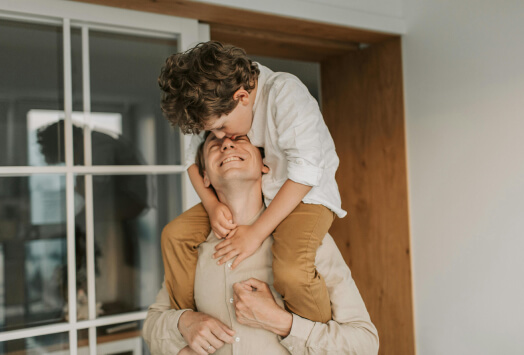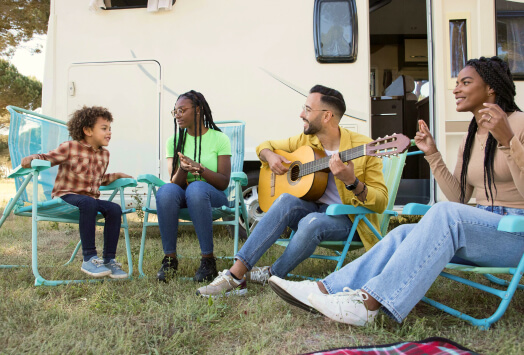When a child learns how to ride a bike, their world widens. Teaching a child how to ride a bicycle can be a struggle, but the investment pays off by fostering independence and confidence in little ones. If you’re not sure where (or when) to introduce your child to cycling, you’re not alone. Most adults learn how to ride a bike as children and over time the skill becomes instinctual — but the fact that you’re doing your research puts you one step ahead of the game.
What age should a child ride a bike?
There isn’t a perfect age to teach a child to ride a bike. Some children learn to ride when they’re in preschool while some take longer. Experts recommend that children learn to bike between the ages of 3 and 8 — but every kid is different. Ask your child if they want to learn to ride a bike and listen to their answer. If a child wants to learn, start teaching them. If they want to wait, listen to their reasoning and respect their decisions. You can revisit bike riding in a few months or even a year.

How to teach a kid to ride a bike
1. Purchase a bike that fits your child
Before you can even start teaching, you need to make sure you have the right gear for learning to ride a bike. Namely: a bike that fits your child.
Purchasing a bike should be fun, but don’t let your child pick out a bicycle without making sure that it fits their body. A good test of fit is to make sure a child can stand over the bike with both feet comfortably touching the ground. Avoid getting a bike that your child will grow into. Although it might seem financially wise, a large bike can be difficult and scary for a child to control.
Buying a bike that fits a child also helps children feel confident when they’re learning to ride a bike. If they’re wobbly or in danger of crashing, they can control the situation by standing up or stepping down.
2. Start with safety
When you start teaching a child to ride a bike, make sure safety is top of mind. Find a flat and paved residential sidewalk, cul de sac, or park path that is far away from speedy traffic.
Once you find a safe place to practice, encourage good helmet habits by making sure your child wears a helmet every time they go near a bike. You’ll need to make sure the helmet fits properly: it should sit level on their forehead, the helmet straps should form a “V” shape, and the helmet should remain buckled. If you aren’t sure a helmet is tight enough, check by slipping one or two fingers between the helmet strap and your child’s chin.
3. Don’t use training wheels
Yes, you heard that correctly! Training wheels are a thing of the past. Instead, start young bike riders off on a balance bike. Studies have shown that children who start on a balance bike often have an easier time learning to ride a bike than those who start on training wheels. If your child is embarrassed or reluctant to ride a balance bike, consider modifying their wheeled bike until they get the hang of it. To do that, just remove the pedals from their current bike and then put them back on when they are ready.
If your child struggles with balance, try enrolling them in a yoga class. Yoga classes help children build confidence and body awareness that will make riding a bike easier!

4. Keep it slow and easy
Once your child is comfortable sitting on a bike, you’ll want to teach them to scoot and glide. They can hop, run, walk, and move until they get a sense of balance. Keep lessons slow and easy — if your child is easily overwhelmed, consider breaking bike lessons into 15 or 30-minute sessions every couple of days. Practice makes perfect, but you don’t want your child to feel exhausted by something that should be fun.
If you’re looking for additional activities to complement bike riding, your child can focus on developing gross motor skills in online and in-person classes. Likewise, you can encourage them to explore more outdoor play activities like hopscotch, bird watching, and raking leaves.
5. Let kids set their own goals and don’t force yours
You’re excited to teach your kid how to bike. Soon, they’ll be able to go on adventures with your family, and when they're a little older, their friends. But, make sure your excitement doesn’t push your child’s limits. When teaching a kid how to bike, let them practice riding at their own pace. When you let a child guide their cycling journey, you encourage them to fall in love with biking.
There’s always a chance a child may become anxious about getting on two wheels. If you’re struggling with teaching a scared child to ride a bike, consider having a heart-to-heart. Learning a new skill can be stressful. If your child feels anxious, stay positive, go slow, and listen to your child’s boundaries.
6. Don’t forget the fun!
Learning to ride a bike can be frustrating for kids and their parents. If a child is a slow learner, stay positive! Being patient, kind, and making the process feel easy can go a long way toward building a child’s confidence. Make sure to reward your child when things go well, talk about the things that could be improved, and make every practice session feel like a blast.
7. Look to the experts
If you are finding that teaching your child to ride a bike is causing stress or tension in your relationship, take a step back. Your child might do better by learning from an expert, like Sawyer educator PedalPower Kids, which teaches children to ride a bike and leads bike riding adventures. You can also ask a trusted teacher or coach to help teach your child, since they might already feel comfortable learning from that person.

Remember, teaching your child to ride a bike should be a fun, core memory for you both. If it feels forced or overwhelming, the time might not be right. That's ok! There is no age limit for learning to ride a bike. The most important thing is to develop good, healthy habits. If you are looking for great in-person and online activities for the whole family, check out what our wonderful educators are offering on Sawyer! We hope to see you out there!
















